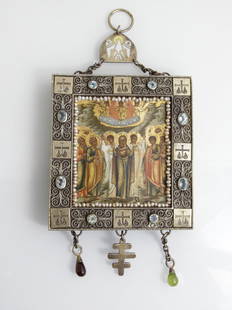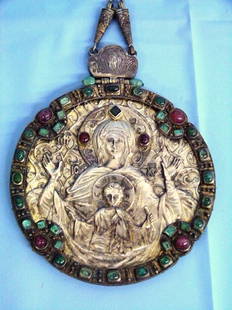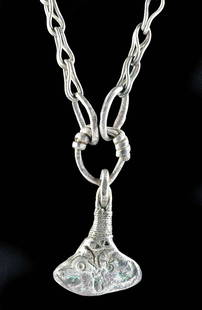
18th C. European Neoclassical Glass Intaglios
Similar Sale History
View More Items in Necklaces & PendantsRelated Necklaces & Pendants
More Items in Neoclassical Necklaces & Pendants
View MoreRecommended Jewelry
View More



Item Details
Description
Western Europe, France or Italy, Neoclassical period, ca. 18th to 19th century CE. A fabulous trio of stamped paste glass intaglios: one featuring a faun carrying a drunken maenad who holds a thyrsus, another of a kneeling nude satyr and a woman sacrificing a serpent before a herm and a hanging goat's head, and the last showing the left-facing head of Hermes - Roman Mercury - wearing a winged Phrygian cap. The faun and maenad present the retrograde Latin inscription "MARCHANT F[ECIT] ROMA" or "Made in Rome by Marchant" along the right side, indicating that this impression is from a now lost original by Nathaniel Marchant (English, 1739-1816). The 2 complete intaglios can be easily set into a ring, necklace, or bracelet for an elegant piece of wearable history! Size of largest (faun and maenad): 0.9" W x 1.1" H (2.3 cm x 2.8 cm)
Popular throughout the 19th century and still collectible today, stamped glass intaglios, like these, are known as Tassies or Tassie gems after their Scottish creator, James Tassie, and his nephew, William Tassie, who developed a method to mold engraved intaglios into glass gems. Nathaniel - sometimes spelled Nathanial - Marchant was one of the most prominent neo-classical gem engravers of the 19th century, and this intaglio was based off of a relief in Palazzo Mattei in Rome. The British Museum describes Marchant with the following: "Gem-engraver, antiquary and dealer, working in London and Rome. A pupil of Edward Burch (qv), Marchant was the foremost prizewinner of the Society of Arts competitions in intaglio engraving, winning four years running from 1761-64. He exhibited at the Royal Academy from 1781 to 1811 and was made an ARA in 1791. In 1772 he left for Rome to study at first hand the famous sculptures of classical antiquity. This was to bear fruit in his 'Catalogue of 100 Impressions from Gems', published in 1792 and the major source for his oeuvre. The impressions were accompanied by a printed text explaining the subjects of each gems. Many were taken from the antique, while others were adapted from celebrated paintings or were portraits of his contemporaries, especially his patrons. These included the lawyer Matthew Duane, the 4th Duke of Marlborough and the 2nd Earl Spencer. On his return from Rome he was made 'Sculptor of Gems' to the Prince of Wales in 1789, and then 'Chief Engraver to His Majesty' in 1799, supplying Seals of State as needed. In 1797 he became engraver at the Mint, producing a head of George III used on several coins from 1804; in 1800 he was appointed Engraver at the Stamp Office, engraving dies for stamp duties and taxes. He remains one of the greatest English gem-engravers. The British Museum acquired gems by Marchant during his lifetime from the bequest of the Rev. C. M. Cracherode in 1799, including gems previously been owned by Matthew Duane. Some of the Museum's greatest gems by Marchant were destroyed in an air raid in 1941."
A similar intaglio of the faun and maenad can be found at the British Museum under museum number 1799,0521.78, and a cameo with a nearly identical portrayal of a satyr and woman sacrificing a serpent can be found in the Beazley Archive at University of Oxford under reference number 13.II.A.539 or in the current collection of Cades, T.: Impronte dell' Instituto: Libro 13, classe II, A no. 539.
Provenance: East Coast collection, New York Gallery, New York City, New York, USA, acquired before 2010
All items legal to buy/sell under U.S. Statute covering cultural patrimony Code 2600, CHAPTER 14, and are guaranteed to be as described or your money back.
A Certificate of Authenticity will accompany all winning bids.
We ship worldwide to most countries and handle all shipping in-house for your convenience.
#175573
Popular throughout the 19th century and still collectible today, stamped glass intaglios, like these, are known as Tassies or Tassie gems after their Scottish creator, James Tassie, and his nephew, William Tassie, who developed a method to mold engraved intaglios into glass gems. Nathaniel - sometimes spelled Nathanial - Marchant was one of the most prominent neo-classical gem engravers of the 19th century, and this intaglio was based off of a relief in Palazzo Mattei in Rome. The British Museum describes Marchant with the following: "Gem-engraver, antiquary and dealer, working in London and Rome. A pupil of Edward Burch (qv), Marchant was the foremost prizewinner of the Society of Arts competitions in intaglio engraving, winning four years running from 1761-64. He exhibited at the Royal Academy from 1781 to 1811 and was made an ARA in 1791. In 1772 he left for Rome to study at first hand the famous sculptures of classical antiquity. This was to bear fruit in his 'Catalogue of 100 Impressions from Gems', published in 1792 and the major source for his oeuvre. The impressions were accompanied by a printed text explaining the subjects of each gems. Many were taken from the antique, while others were adapted from celebrated paintings or were portraits of his contemporaries, especially his patrons. These included the lawyer Matthew Duane, the 4th Duke of Marlborough and the 2nd Earl Spencer. On his return from Rome he was made 'Sculptor of Gems' to the Prince of Wales in 1789, and then 'Chief Engraver to His Majesty' in 1799, supplying Seals of State as needed. In 1797 he became engraver at the Mint, producing a head of George III used on several coins from 1804; in 1800 he was appointed Engraver at the Stamp Office, engraving dies for stamp duties and taxes. He remains one of the greatest English gem-engravers. The British Museum acquired gems by Marchant during his lifetime from the bequest of the Rev. C. M. Cracherode in 1799, including gems previously been owned by Matthew Duane. Some of the Museum's greatest gems by Marchant were destroyed in an air raid in 1941."
A similar intaglio of the faun and maenad can be found at the British Museum under museum number 1799,0521.78, and a cameo with a nearly identical portrayal of a satyr and woman sacrificing a serpent can be found in the Beazley Archive at University of Oxford under reference number 13.II.A.539 or in the current collection of Cades, T.: Impronte dell' Instituto: Libro 13, classe II, A no. 539.
Provenance: East Coast collection, New York Gallery, New York City, New York, USA, acquired before 2010
All items legal to buy/sell under U.S. Statute covering cultural patrimony Code 2600, CHAPTER 14, and are guaranteed to be as described or your money back.
A Certificate of Authenticity will accompany all winning bids.
We ship worldwide to most countries and handle all shipping in-house for your convenience.
#175573
Condition
Loss to half of Hermes intaglio and expected nicks and abrasions to all 3. Other 2 are intact and excellent with impressive remaining detail.
Buyer's Premium
- 26.5%
18th C. European Neoclassical Glass Intaglios
Estimate $300 - $450
3 bidders are watching this item.
Get approved to bid.
Shipping & Pickup Options
Item located in Louisville, CO, usSee Policy for Shipping
Local Pickup Available
Payment
Accepts seamless payments through LiveAuctioneers

TOP









































































